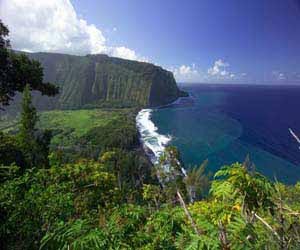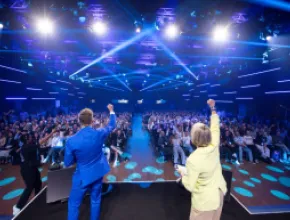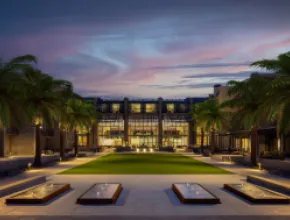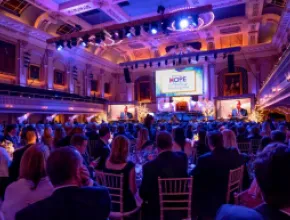Among the unique islands of the Hawaiian archipelago, the Big Island must be considered its own separate entity, and is in many ways defined by its terrain. One of its five peaks, Kilauea, is the world’s most consistently active volcano, each year adding more acreage to the island’s coastline. Another dormant volcano, Mauna Kea, rises over 33,000 feet from the ocean floor, and tops lists as the world’s tallest mountain.
While Hawaii’s reputation is primarily tropical, the Big Island also features 11 of the world’s 13 main climate zones, from pristine beaches to rain forest, high desert, mountain and even snow. Two airports on either side of the island, Kona and Hilo, each provide easy access to accommodations, activities and adventures. Add to this the quiet unpopulated landscape and the rich Polynesian history of ancient voyagers, and it’s no wonder the Big Island attracts a steady stream of meeting and incentive business.
"Hawaii’s Big Island is in many ways unspoiled," says Debbie Hogan, senior director of sales for the Big Island Visitors Bureau. "We remain true to our sense of place and our need to share this spirit with our travelers, whether group or leisure oriented. With the economic downturn, we are adjusting as are all other destinations. But the island is most optimistic. We understand that conducting meetings and incentives is a necessary part to grow and maintain business culture."
In recent months, Hogan says offering groups an "easy buy" has been the biggest trend.
"To have a successful event today means satisfying the attendees—and ensuring the group operators that they can meet objectives by having guaranteed options, whether activities, culture, cuisine and island beauty, in the very location of the event."
Kohala Coast
Perched on the island’s northwest corner, this so-called "Gold Coast" features the island’s best beaches, with upscale luxury resorts and world-class golf courses rising up out of the dramatic ebony lava fields. With less than eight inches of rainfall a year, it’s no wonder the ancient Hawaiian royalty chose this area as their personal playground.
Chief properties include Waikoloa Beach Resort, an immense sprawl of condos and hotels encompassing Hilton Waikoloa Village and Waikoloa Beach Marriott Resort & Spa, with more than 1,550 guest rooms between the two properties. The Hilton alone boasts more than 235,000 square feet of meeting, convention and outdoor function space.
In addition to the ultimate in shopping, dining, pampering and entertainment options, Waikoloa is also home to two stunning golf courses: the Robert Trent Jones Jr.-designed oceanfront Beach Course and the Scottish links-style Kings’ Course, designed by Tom Weiskopf and Jay Morrish.
Another sprawling conglomeration along the coast, the 1,839-acre Mauna Kea Resort features two white-sand beaches attached to two spectacular properties, the Hapuna Beach Prince Hotel and the Mauna Kea Beach Hotel. Hapuna features over 85,000 square feet of meeting space, and its 18-hole championship course has been called "the course of the future" for its dramatic design, challenging play and environmental sensitivity. Mauna Kea offers 258 updated guest rooms and a museum-quality Pacific/Asian art collection, and its ample meeting spaces.
Farther down the shore, the 32-acre Fairmont Orchid resort features a year-round children’s program, four restaurants, three lounges, more than 31,000 square feet of indoor meeting space and 76,000 square feet of outdoor event venues.
The Mauna Lani Bay Hotel & Bungalows, closed until Nov. 1 for renovations, offers three miles of coastline, with walking trails through acres of fishpond preserve, historic parks and ancient caves and petroglyphs. A private conference wing of the hotel opens onto a large open-air lanai, with a teak-floor ballroom, breakout rooms and the 800-seat Hale Hoaloha Pavilion.
Kailua-Kona Area
The Kona District stretches about 60 miles along the Big Island’s western coast, from the international airport to Kealakekua Bay, where Captain James Cook first set foot on the island in 1778, and the nearby Puuhonua o Honaunau, a restored Hawaiian "place of refuge" that predates Western contact. Kona seems to never sleep, from Ironman triathlete competitions to sportfishing tournaments, cruise ship traffic and film crews, all enveloped in the lingering aroma of the region’s world-famous Kona coffee.
Meeting and incentive business naturally follows to Kona’s Keauhou Resort area, where Keauhou Bay is ringed by Sheraton and Outrigger properties. The world-class 521-room Sheraton Keauhou Bay Resort & Spa is home to the 22,000-square-foot Keauhou Convention Center, the Kona Coast’s largest meeting facility.
The adjacent Outrigger Keauhou Beach Resort features tide pools with sea turtles, a six-court tennis facility and historic Hawaiian sites. Meeting and reception areas include a 6,900-square-foot Kahaluu Conference Room with garden and ocean views.
Parked in low-rise bungalows along the coast, the 243-room AAA Five Diamond Four Seasons Resort Hualalai contains its own private Jack Nicklaus Signature 18-hole golf course, as well as Hualalai Sports Club & Spa. Its variety of indoor and outdoor meeting spaces accommodate groups of up to 600 people.
In the heart of Kailua-Kona, smaller properties shine with affordable combinations of guest rooms and meeting space.
King Kamehameha’s Kona Beach Hotel overlooks Kona’s only pristine white-sand beach, and its 458 guest rooms are supported by meeting and prefunction spaces that include a 5,200-square-feet ballroom. The Royal Kona Resort boasts more than 10,000 square feet of conference and banquet space, with outdoor facilities that are ideal for luaus, theme parties and receptions of up to 500 people.
Hilo Area
Built around a crescent bay on the island’s eastern side, Hilo is known for surviving two tsunamis in 1946 and 1960, and also as the headquarters for Hawaii’s Merrie Monarch Hula Festival, a week-long celebration of Hawaii’s ancient dance tradition. An international airport opens up the area to visitors interested in a true sense of a lush tropical island destination.
Two primary Hilo properties cater to meeting and incentive groups, and both are less than an hour away from the live volcano eruptions in Hawaii Volcanoes National Park. The 286-room Castle Hilo Hawaiian Hotel sits on Hilo Bay and offers excellent views of both the ocean and Hilo town. Amenities include a restaurant and bakery, a fresh-water swimming pool and nine holes of golf. Meeting rooms can accommodate groups of up to 600 people.
Currently finishing a major property restoration, Naniloa Volcanoes Resort provides excellent vistas of both Mauna Kea and Hilo Bay. Groups can meet in two off-site locations: The Volcano House country inn and restaurant, located inside Hawaii Volcanoes National Park, and Nani Mau Gardens, a popular outdoor facility for receptions and parties four miles from the hotel.
Big Island off-site venues are many and varied, but according to Hogan, three in particular are catching the attention of meeting planners. The Parker Ranch Rodeo Arena, located in the northern mountain valleys, is home of Hawaii’s cowboys (paniolos) and can accommodate up to 2,000 guests in a combination of covered and outdoor seating configurations.
The Imiloa Astronomy Center, located on a nine-acre campus above Hilo Bay and the University of Hawaii-Hilo, offers fully equipped venues for meetings and conferences. Groups can utilize a large exhibit hall, a classroom, outdoor gardens and a restaurant, and delegates will also enjoy the 120-seat planetarium with 3-D, full-dome projection.
The Waikoloa Beach Resort complex is also perfect for visiting groups, with ample shopping, dining and entertainment options at the Queens’ MarketPlace. The adjoining Waikoloa Bowl, a venue under the stars, can handle larger events with a capacity of up to 5,000 people.
"Aloha exists and is engrained in our Big Island community and we love to share it," Hogan says. "The Big Island has more marine life conservation districts than any other island. There are beaches here where sea turtles outnumber the people!"






